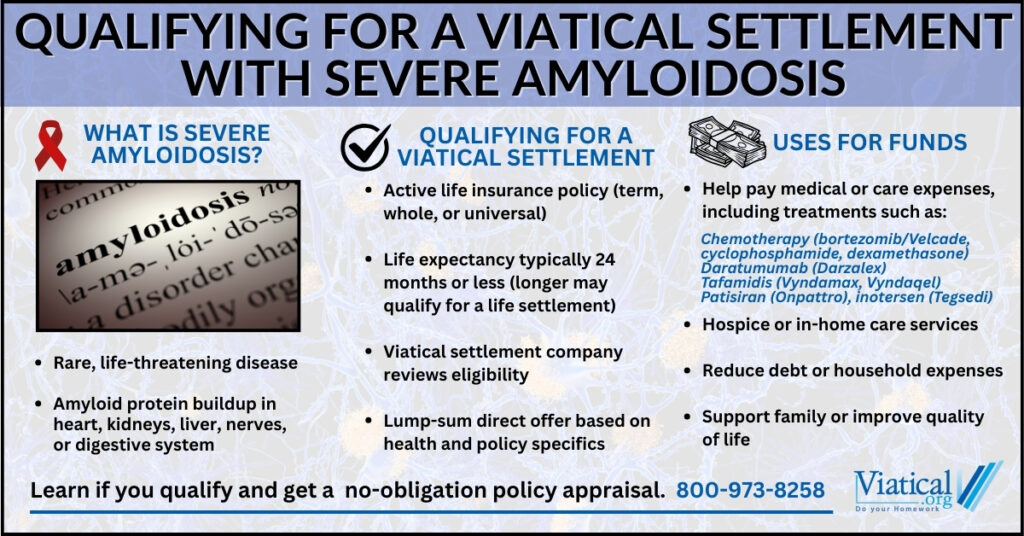Qualifying for a viatical settlement with severe amyloidosis can provide critical financial support for individuals facing this rare and life-threatening condition. If you or a loved one is facing this difficult diagnosis, understanding your financial options can provide much-needed relief during a challenging time.

What is Amyloidosis?
Amyloidosis occurs when abnormal proteins, known as amyloid, build up in tissues and organs. These deposits interfere with normal organ function and can affect the heart, kidneys, liver, nervous system, and digestive tract. While amyloidosis is rare, it can progress rapidly and significantly shorten life expectancy, especially when the heart or kidneys are involved.
There are several types of amyloidosis:
- AL (light-chain) amyloidosis: The most common type, linked to plasma cell disorders in the bone marrow.
- ATTR (transthyretin) amyloidosis: Caused by abnormal transthyretin protein; can be hereditary or age-related (wild-type ATTR).
- AA amyloidosis: Associated with chronic inflammatory conditions such as rheumatoid arthritis or inflammatory bowel disease.
Treatments and Medications for Severe Amyloidosis
Treatment for amyloidosis depends on the type, but often focuses on slowing the production of amyloid proteins and managing organ damage. For severe cases, treatment options may include:
- AL amyloidosis treatments:
- ATTR amyloidosis treatments:
- Tafamidis (Vyndamax, Vyndaqel), a transthyretin stabilizer that slows disease progression, especially in cardiac ATTR.
- Patisiran (Onpattro) and inotersen (Tegsedi), RNA-targeted therapies that reduce transthyretin production for hereditary ATTR.
- Liver transplantation, historically used in hereditary cases.
- AA amyloidosis treatments:
- Controlling the underlying inflammatory disease using medications such as tumor necrosis factor (TNF) inhibitors or colchicine.
Unfortunately, even with treatment, severe amyloidosis often leads to irreversible organ damage, making long-term survival uncertain.
How to Qualify for a Viatical Settlement with Severe Amyloidosis
Individuals with severe amyloidosis may qualify for a viatical settlement if they have a life expectancy of two years or less. This option allows policyholders to sell their life insurance policy to a licensed buyer for a lump-sum cash payment, providing funds that can be used for:
- Medical bills and out-of-pocket treatment costs
- In-home care or hospice services
- Travel to specialized treatment centers
- Supporting loved ones and maintaining quality of life
Most types of life insurance policies qualify, including term, whole life, and universal life policies, provided they meet the minimum value requirements (typically a death benefit of $100,000 or greater) and have been in force for at least two years.
If someone has a longer life expectancy than what qualifies for a viatical settlement, they may still qualify for life settlements.
Next Steps
If you or someone you care about has been diagnosed with severe amyloidosis, it may be worth exploring whether a viatical settlement can provide the financial help you need. Call us today to understand your options and obtain a no-obligation policy appraisal. 800-973-8258
Qualifying for a viatical settlement with severe amyloidosis can offer peace of mind and critical financial support during an especially challenging time.

